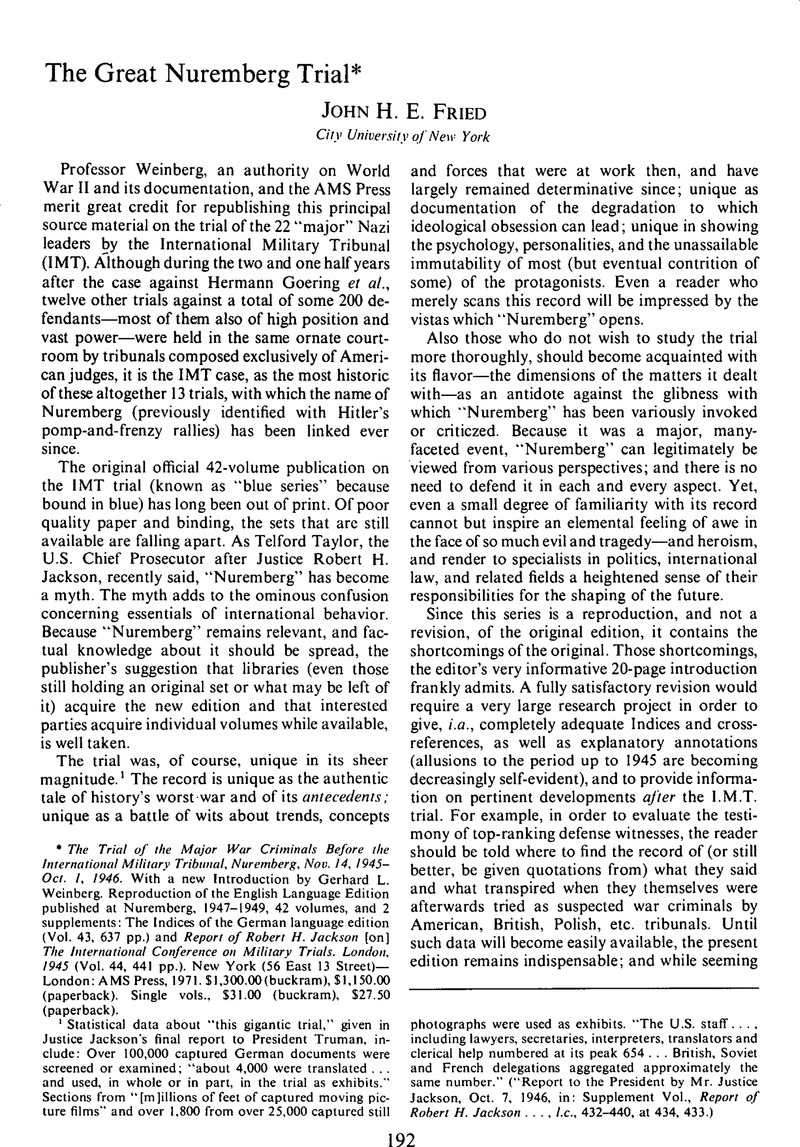Published online by Cambridge University Press: 01 August 2014

1 Statistical data about “this gigantic trial,” given in Justice Jackson's final report to President Truman, include: Over 100,000 captured German documents were screened or examined; “about 4,000 were translated … and used, in whole or in part, in the trial as exhibits.” Sections from “[m]illions of feet of captured moving picture films” and over 1,800 from over 25,000 captured still photographs were used as exhibits. “The U.S. staff…, including lawyers, secretaries, interpreters, translators and clerical help numbered at its peak 654 … British, Soviet and French delegations aggregated approximately the same number.” (“Report to the President by Mr. Justice Jackson, Oct. 7, 1946, in: Supplement Vol., Report of Robert H. Jackson …, l.c., 432–440, at 434, 433.)
2 One of the two supplemental volumes in this series reproduces Mr. Jackson's Report on the 4-Power London Conference of July 1945 (originally published by the State Department in 1949). It shows the evolution at that Conference of the Nuremberg Charter which formed the basis of the IMT and the other 12 Nuremberg trials, as well as of the Tokyo international trial of the major Japanese War Criminals, and of what became known as the Nuremberg Principles. A caveat must be expressed concerning this printed version of the minutes of the London Conference. They constitute transcriptions of the stenographic notes taken in English by Mr. Jackson's secretary, and hence include translations of the statements by the Russian (Judge I. T. Nikitchenko, assisted, La., by Prof A. N. Trainin) and French (Judge Robert Falco, assisted, i.a., by Prof. André Gros) delegations. As pointed out in the Foreword, “The minutes [were] not submitted to the French, Soviet or British Delegations for verification or editing [before being printed in this volume].” (p. xiii; italics added).
3 Including severance of the case of old Herr Krupp von Bohlen (too senile to stand trial) but not of Rudolf Hess (able to stand trial). The respective medical reports are also reproduced in vol. I.
4 The reading of the Judgment in open court took the last two days of the trial (Sept. 30, Oct. I, 1946). Its text therefore also appears in the record of those days (vol. 22, pp. 411–589), and shows how the four Judges alternated in the reading. This has been of interest to analysts who believe (with certain internal justifications, but without proof) that each Judge read the sections about the topics primarily assigned to him.
5 The arch-major criminals, Hitler and Himmler, escaped the trial through suicide. Nevertheless, Nuremberg had to deal with them, especially insofar as their orders concerned the defendants. The supersecret documents emanating from them reveal their policies and intentions in dimensions of enormity still largely not realized. On the other hand, the Nuremberg materials also throw light on various other aspects stressed by the Defense—such as the support certain Nazi aims received from important non-Germans.
6 The term “genocide” does nol occur either as formal charge or in the Nuremberg Charter or Judgment. This would have been retroactive, as the crime was technically defined only in the Genocide Convention of 1948.
7 “Defense Counsel are advised that the Tribunal will not ordinarily regard as competent evidence, extracts from books or articles expressing the opinions of particular authors on matters of ethics, history, or particular events” (Ruling by the President, 22 March 1946, vol. 9, p. 673).
8 Not all documents accepted in evidence at Nuremberg (and certainly not, all that were available) are reprinted in this set. Many more of them are contained in the U.S. Government publication prepared at JusticeJackson's, initiative, “Nazi Conspiracy and Aggression” (Washington, D.C., 1946–1949 Google Scholar; known as the “red series”). In these bulky 10 volumes, all documents are given in English, but the translations, done at Nuremberg under great pressure, are not completely reliable. Finally, it should be noted that the 15-volume “green series” edited by Sprecher, Drexel R. and myself, “Trials of War Criminals Before the [U.S.] Nuremberg Military Tribunals” (Washington: Govt. Printing Office, 1950–1953)Google Scholar, covering the 12 subsequent trials of altogether almost 200 defendants (cases against Krupp; I. G. Farben; Fieldmarshals and generals; Cabinet ministers and diplomats: the Acting Minister of Justice and high judges; Luftwaffe and other physicians involved in the “medical experiments,” “euthanasia,” castration programs; leaders of the concentration camp system, and of extermination units; etc.) contain many documents (all in carefully checked English translations) that had been used by or were available to the I.M.T. Unfortunately, it was not possible to provide the “green series” with indices.
9 Among various statements to the same effect, see, for example, Directives by the Economic Staff East (Wirtschaftsführungsstab Ost) of the Supreme Command of the Armed Forces (OKW) of September 1, 1942: “Germany must be the power that obliterates (zertrümmert) Bolshevism, and the Führer must be celebrated (gefeiert) by the peoples of the Soviet Union as the liberator from the bolshevist yoke.” (347-EC, Exh. USA-320, vol. 36, pp. 331–355, at 346). There is no entry, “Bolshevism” in the Subject Index.
Comments
No Comments have been published for this article.